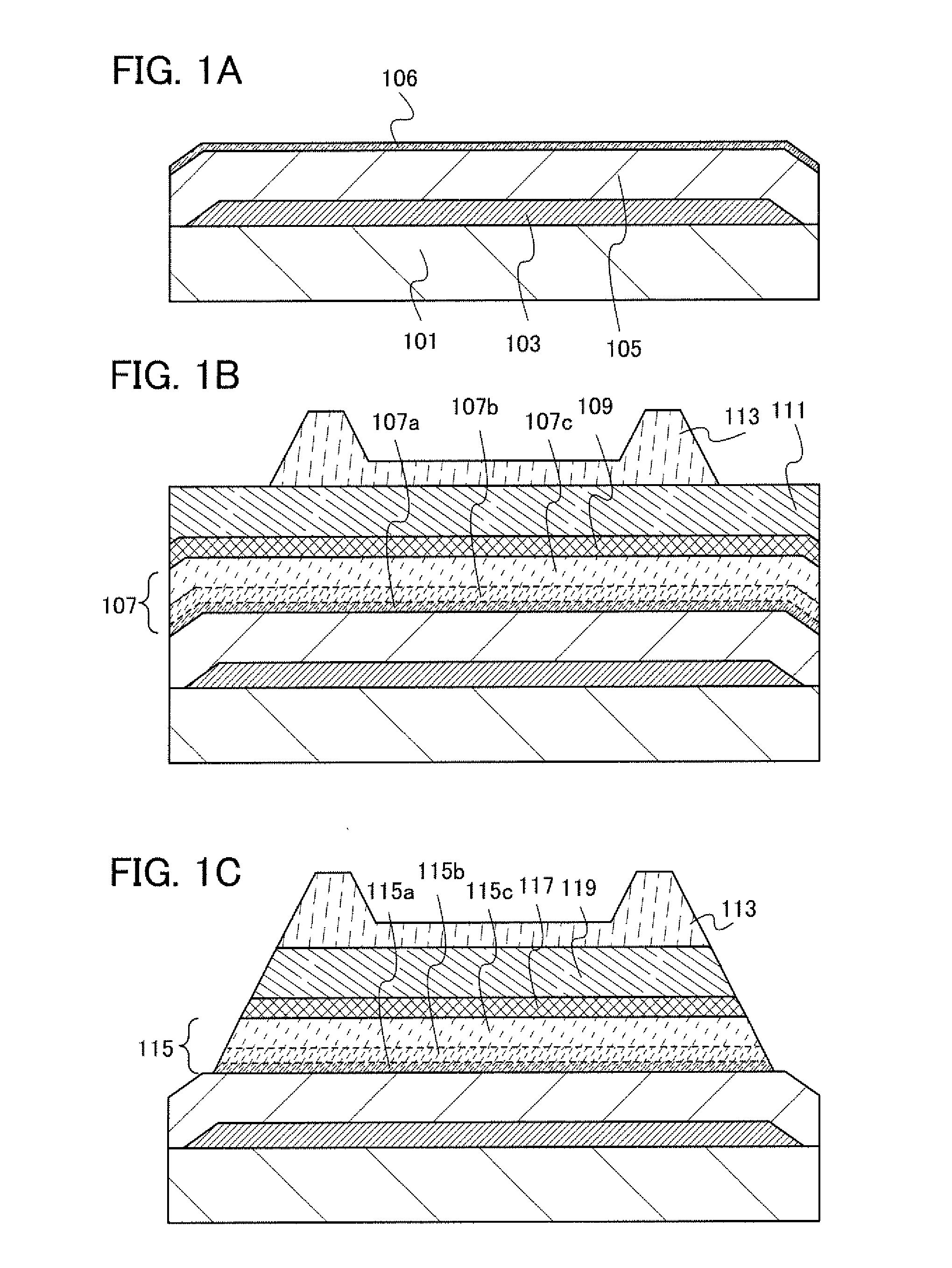Method for manufacturing thin film transistor
a thin film transistor and display device technology, applied in the direction of coatings, solid-state devices, chemical vapor deposition coatings, etc., can solve the problems of high manufacturing cost, inability to obtain sufficient switching characteristics, and low field-effect mobility and small on-current, so as to increase the active species amount, increase the deposition rate of the first semiconductor layer, and promote the reaction between active species
- Summary
- Abstract
- Description
- Claims
- Application Information
AI Technical Summary
Benefits of technology
Problems solved by technology
Method used
Image
Examples
embodiment 1
[0042]In Embodiment 1, a method for manufacturing a thin film transistor is described with reference to FIGS. 1A to 1C, FIGS. 2A and 2B, FIG. 3, FIGS. 4A1, 4A2, 4B1, and 4B2, FIGS. 5A to 5C, FIG. 6, FIG. 7, FIG. 8, and FIG. 9. An n-channel thin film transistor has higher carrier mobility than a p-channel thin film transistor. In addition, it is preferable that all thin film transistors formed over the same substrate have the same conductivity to reduce the number of manufacturing steps. Therefore, in Embodiment 1, a method for manufacturing an n-channel thin film transistor is described.
[0043]A gate electrode 103 is formed over a substrate 101. Then, a gate insulating layer 105 is formed so as to cover the gate electrode 103. A first semiconductor layer 106 is formed over the gate insulating layer 105 (see FIG. 1A).
[0044]As the substrate 101, a glass substrate, a ceramic substrate, a plastic substrate which has high heat resistance enough to withstand a process temperature of this m...
embodiment 2
[0126]In Embodiment 2, one embodiment of a plasma CVD apparatus which can be used for forming the gate insulating layer 105, the first semiconductor layer 106, the second semiconductor layer 107, and the impurity semiconductor layer 109 is described in detail. These layers are formed by a CVD method or the like.
[0127]A plasma CVD apparatus 261 illustrated in FIG. 6 is connected to a gas supply means 250 and an exhaust means 251.
[0128]The plasma CVD apparatus 261 illustrated in FIG. 6 includes a treatment chamber 241, a stage 242, a gas supply portion 243, a shower plate 244, an exhaust port 245, an upper electrode 246, a lower electrode 247, an alternate-current power source 248, and a temperature control portion 249.
[0129]The treatment chamber 241 is formed using a material having rigidity and the inside thereof can be evacuated to vacuum. The treatment chamber 241 is provided with the upper electrode 246 and the lower electrode 247. Note that in FIG. 6, a structure of a capacitive...
embodiment 3
[0135]In Embodiment 3, a process of forming a second semiconductor layer 107 which can be applied to Embodiment 1 are described.
[0136]In Embodiment 3, the inside of a treatment chamber is cleaned before the second semiconductor layer 107 is formed, and after that, the inner wall of the chamber is covered with a silicon nitride layer, whereby nitrogen is included in the second semiconductor layer 107, the oxygen concentration is made low, and the nitrogen concentration is made higher than the oxygen concentration. A series of steps from a step of forming the gate insulating layer 105 to a step of forming the first semiconductor layer 106 is similar to that in Embodiment 1; thus, a series of steps from a step of forming a second semiconductor layer 107 to a step of forming an impurity semiconductor layer 109 is described below with reference to FIG. 7.
[0137]The first semiconductor layer 106 is formed over the entire surface of the gate insulating layer 105. First, the source gases use...
PUM
| Property | Measurement | Unit |
|---|---|---|
| size | aaaaa | aaaaa |
| size | aaaaa | aaaaa |
| size | aaaaa | aaaaa |
Abstract
Description
Claims
Application Information
 Login to View More
Login to View More - R&D
- Intellectual Property
- Life Sciences
- Materials
- Tech Scout
- Unparalleled Data Quality
- Higher Quality Content
- 60% Fewer Hallucinations
Browse by: Latest US Patents, China's latest patents, Technical Efficacy Thesaurus, Application Domain, Technology Topic, Popular Technical Reports.
© 2025 PatSnap. All rights reserved.Legal|Privacy policy|Modern Slavery Act Transparency Statement|Sitemap|About US| Contact US: help@patsnap.com



